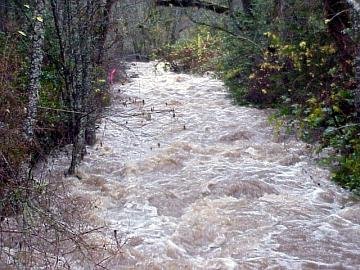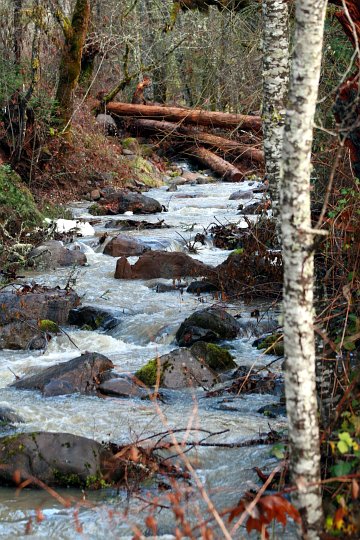~~* The Singing Falls Stream Restoration Project *~~
 ϕ
ϕ
~~*Salmon: Seeking Shelter From The Storm*~~
For people, being stuck in a back water is something undesirable. For salmon, it can be the key to survival.
Like all creatures in the wild, salmon need refuges from the harshest winter weather. For salmon, the greatest threat is high water flows during the winter. This is especially true for coho (or “silver“) salmon, which tend to rear as juveniles in small tributary streams where the effects of floods can be more dramatic.
In undisturbed stream systems, coho seek shelter from high flows in back water areas such as side sloughs, wetlands, beaver ponds and “alcove pools” off the main channel. They also seek shelter behind log jams and downed trees, habitat that scientists call “complex woody structure.” The jumble of downed trees, broken branches, rootwads, and streamside vegetation that are found in undisturbed stream environments provide hiding spaces that enable salmon to protect themselves from the full force of rushing water. At the same time, these habitats produce large numbers of the invertebrates that young salmon eat.

Winter stream with no refuge
One reason that salmon (especially coho) are in decline throughout much of the Northwest is the loss of these critical winter havens. The majority of streams have been altered by logging, agriculture, road-building and water-side development. Most streams are now deficient in woody material and many of the backwater oxbows, wetlands and floodplains have been filled and straightened. Meanwhile, where forests and wetlands have been removed, storm run-off is greater and peak flows are higher. Coho are particularly vulnerable to this double whammy, because the effects are magnified in the smaller streams where they reside. Research in Oregon shows that in a typical stream with limited winter habitat, only 10-20% of the juvenile coho present at the end of the summer survive until the following spring.
Efforts are under way to improve the winter habitat situation in many watersheds. In the short term, the missing “woody structure” is being replaced manually in some streams, through the addition of large logs and smaller material (such as old Christmas trees). In the longer term, projects are being undertaken that involve digging side channels that will fill during winter floods, planting new trees and fencing livestock away from stream banks.

Stream restoration
A project that has been underway in the watershed of Oregon's Coquille River since 1988 illustrates the possibilities. Directed by the Coquille Watershed Association, a voluntary group which reflects all major resource users in the valley and which is funded through a variety of state, local, federal and private sources, the project is aimed squarely at improving winter habitat for coho. A total of 12 off-channels ponds have been dug, some of which hold water year-round and some of which are designed to fill only at high water flows. A creek which had been imprisoned in a culvert has been 'day- lighted' and allowed to flow into an artificially created wetland. Many other culverts which had blocked fish from entering small tributary streams, have been altered to allow salmon to pass through into good habitat areas. Logs and other woody debris have been placed in the river to create pools and shelter. And the results have been dramatic. “As we do these projects, they immediately fill with coho in the wintertime,” says Paul Heikkila, a county extension agent and the watershed association's president.
Landowners can participate in efforts such as this. They can also help by preserving wetlands and beaver ponds on their property, leaving streamside vegetation intact, and fencing out livestock. Landowners willing to help might wish to contact their local watershed association, soil and water conservation district, or county extension office.
To find contacts for groups working to help salmon restoration efforts in your area or for more information on what you can do, please contact the Pacific States Marine Fisheries Commission, 45 SE 82nd Drive, Suite 100, Gladstone, OR 97027-2522.
stream index
top






